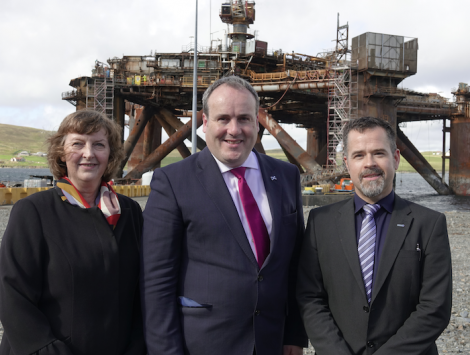News / Big future for decommissioning, event hears
A MAJOR oil and gas event in Shetland on Monday was the scene for announcements that place the isles firmly at the centre of UK plans for oil decommissioning.
A gathering at Dales Voe base of about 140 of the oil and gas “great and good” heard Scottish energy minister Paul Wheelhouse reiterate that Dales Voe is the favoured site for an ultra deep water base for decommissioning with £7.5 million of Scottish money earmarked for such work.
At the same time Allseas formally announced that Peterson Veolia has won the contract for decommissioning the Ninian North platform topsides – the first “single-lift” contract undertaken at the base.
The superstructure will be cut off the legs of the platform before being transported to Dales Voe for scrapping in 2020, by which time the Buchan Alpha platform will have been totally scrapped.
Lerwick Port Authority’s (LPA) retiring chief executive Sandra Laurenson outlined plans for a heavy lift quay costing up to £40 million that will put Dales Voe at the forefront of decommissioning capabilities. Talks on funding that ambitious scheme are continuing with Highlands and Islands Enterprise (HIE), who paid for the event along with the Oil and Gas Authority (OGA).
Laurenson outlined that there are only four ports in Europe that match Dales Voe’s single-lift capabilities and only two ultra deep water heavy lift quays – both in Norway. Investment in a 24m deep quayside would combine both capabilities in Dales Voe and nearly double the working space, giving the plant the ability to handle multiple decommissioning jobs.
The gathering was also a showcase for all the assets LPA can offer to the oil and gas sector, with meetings in the afternoon allowing all parties to discuss opportunities.
Laurenson said: “I welcome OGA and HIE’s initiative to host this vision event in Shetland and it is encouraging that such an excellent audience has taken time to visit.
Become a member of Shetland News
“I hope they gain new awareness of what Shetland offers and have seen at first-hand how our port is adaptable in meeting the sector’s changing requirements – including being decommissioning-ready. It is vital we all work now to maintain the momentum being generated.”
OGA director of operations Gunther Newcombe said he was optimistic Shetland would play a large part in decommissioning. He said that the event was unique in the numbers of senior managers from operators, pipe line companies, suppliers and the renewable sectors that had gathered in one place.
He said that the OGA’s role was to drive efficiency in decommissioning, the cost of which is jointly shared by the operators and the taxpayer.
Work will continue meanwhile readying the laydown area at Dales Voe for skid unloading of the 12,600 tonne Ninian topsides that will be transported by the Pioneering Spirit heavy lift vessel.
Wheelhouse said that it was a “fantastic opportunity” to secure Scotland and the UK’s foothold in decommissioning and develop a steady local workforce instead of relying on outside contractors.
But with 30 to 40 employed dismantling Buchan Alpha at peak and similar numbers expected for Ninian North, decommissioning will bring only a modest boost to local employment.
Wheelhouse added that there were 322 topsides being decommissioned in the UK alone and a substantial number would require a deep water facility. There would be nothing to stop the Dales Voe operation bidding for Norwegian work too.
He reckoned that 10 major decommissioning jobs would be sufficient to repay investment from the Scottish Government, the port authority and the scrapping partners in Dales Voe infrastructure.
Peterson decommissioning manager James Johnson said that Dales Voe was already the strongest quayside in Britain, being able to take 60 tonnes per square metre. Its first major decommissioning job was from the Frigg field and since then it scrapped 16,000 tonnes from Hess between 2010 and 2013 before work started on Buchan Alpha last year.
Dales Voe’s favoured status as the decommissioning hub came after a UK-wide feasibility study was undertaken by the Scottish Government, and this will also feed into similar research being undertaken by Westminster.
In a joint statement, Northern Isles MP Alistair Carmichael and Shetland MSP Tavish Scott said they “warmly welcomed” the news.
“The islands location makes Shetland the logical place for further decommissioning work from the northern North Sea and the ultra deep water proposal should get support,” they said.
“With the dual capacity to handle projects quayside and in water Shetland can maximise the opportunities presented by decommissioning in the future.”
Become a member of Shetland News
Shetland News is asking its readers to consider paying for membership to get additional perks:
- Removal of third-party ads;
- Bookmark posts to read later;
- Exclusive curated weekly newsletter;
- Hide membership messages;
- Comments open for discussion.
If you appreciate what we do and feel strongly about impartial local journalism, then please become a member of Shetland News by either making a single payment, or setting up a monthly, quarterly or yearly subscription.






























































